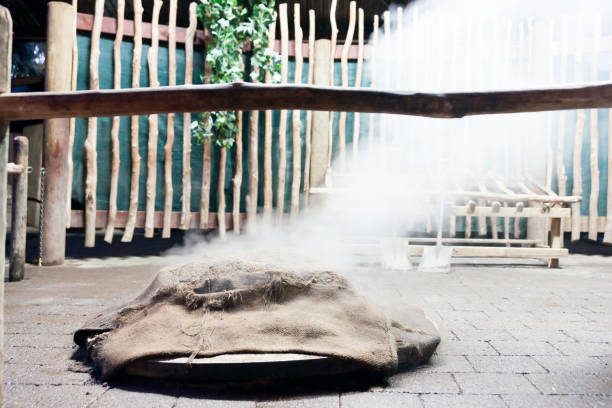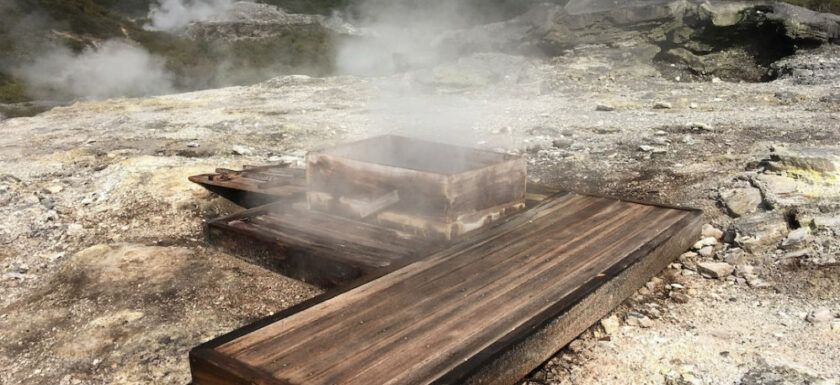If you’re a fan of barbecues, you’ve probably heard of the Hangi, but have some serious questions about its history and purpose. This traditional Māori cooking method has been around for centuries and is a staple of New Zealand’s indigenous culture. But what exactly is a Hangi? In this article, we’ll delve deep into the world of Hangi, discussing everything from its history and cultural significance to its preparation and modern-day adaptations.
What is a Hangi?
A Hangi is a traditional Māori method of cooking that involves digging a pit in the ground and using it to steam food. The pit is lined with hot stones, and the food is placed on top of the stones. The pit is then covered with damp cloth and earth, which traps the heat and steam, cooking the food to perfection.
The Hangi is a communal cooking method and is often used to cook large amounts of food for special occasions and events. It’s a symbol of Māori culture and is often used to celebrate important events such as weddings, funerals, and birthdays.
The History of Hangi
The Hangi has been around for centuries and is an integral part of Māori culture. It was originally used to cook food for large gatherings of people, such as tribes or extended families. The method of cooking was passed down from generation to generation and is still used today in many Māori communities.
The traditional Hangi was cooked in a pit that was dug in the ground. The pit was lined with stones that were heated with fire. Once the stones were hot, the food was placed on top of them, and the pit was covered with earth and leaves. The food was left to cook for several hours, and the result was a smoky, tender, and delicious meal.
The Cultural Significance of Hangi

The Hangi is not just a method of cooking; it’s also a symbol of Māori culture and tradition. The food that is cooked in a Hangi is often symbolic of the event that is being celebrated. For example, at a funeral, the food might include kumara (sweet potato), which is believed to help the deceased find their way to the afterlife.
The Hangi is also a communal activity and is often used to bring people together. The process of preparing the food and cooking it is seen as an important part of the celebration, and everyone is expected to help out. The Hangi is a way of sharing food, culture, and tradition with others.
The Preparation of Your Pit Fire
Preparing a Hangi is a complex and time-consuming process that requires a lot of preparation. The first step is to dig a pit in the ground, which should be around one meter in diameter and one meter deep. The pit should be lined with stones, which are heated with a fire.
Once the stones are hot, the food is prepared and placed on top of them. The food should be wrapped in damp cloth or leaves to keep it moist and to prevent it from burning. The pit is then covered with earth and damp cloth, which traps the heat and steam, cooking the food to perfection.
The food that is traditionally cooked in a Hangi includes meats such as lamb, chicken, and pork, as well as kumara, pumpkin, and other vegetables. The food is seasoned with salt and herbs and is often accompanied by traditional Māori condiments such as pikopiko (fern shoots) and horopito (a native pepper).
Modern-day Adaptations of Hangi
While the traditional Hangi is still used today in many Māori communities, there have been some modern-day adaptations of the cooking method. One popular adaptation is the Hangi-in-a-box, which is a pre-made kit that contains all the necessary ingredients and
What is Geothermal Cooking?
Geothermal cooking involves using the natural heat of the earth to cook food. This technique has been used for centuries by indigenous cultures around the world, and it is still commonly used today 
in places like Iceland and New Zealand. In these regions, the earth’s heat is harnessed to cook food in a variety of ways, from boiling to baking and even smoking.
How Does Geothermal Cooking Work?
Geothermal cooking works by tapping into the heat that is naturally present beneath the earth’s surface. This heat is generated by the earth’s core, which is estimated to be around 6,000 degrees Celsius. In some areas, this heat is close enough to the surface that it can be accessed using geothermal wells or other techniques.
To cook food using geothermal heat, you will need to find a geothermal area that is suitable for cooking. This might be a natural hot spring or a geothermal well that has been specifically designed for cooking. Once you have found your cooking spot, you can start preparing your food.
Cooking Techniques
There are several different techniques that you can use for geothermal cooking, depending on the type of food that you are preparing and the equipment that you have available. Here are a few of the most popular geothermal cooking techniques:
1. Boiling
Boiling is one of the simplest geothermal cooking techniques, and it can be used to cook a wide range of foods, from vegetables to pasta. To boil food using geothermal heat, you will need a pot or other heat-resistant container. Simply place your food in the pot and then submerge it in the hot water from the geothermal source. Depending on the temperature of the water, your food should be cooked within a few minutes to an hour.
2. Baking
Baking is another popular geothermal cooking technique, and it can be used to cook a wide range of foods, from bread to pizza. To bake food using geothermal heat, you will need a heat-resistant container, such as a Dutch oven or a Cast iron skillet.
Simply place your food in the container and then bury it in the hot soil or sand near the geothermal source. Depending on the temperature of the soil, your food should be cooked within a few hours.
3. Smoking
Smoking is a more advanced geothermal cooking technique, and it requires some specialized equipment. To smoke food using geothermal heat, you will need a smoker that is designed to work with geothermal heat. These smokers typically have a heat source that is buried in the ground, along with a smoking chamber that is located above ground. You can use a variety of woods for smoking, depending on the type of flavor that you want to achieve.
Benefits of Geothermal Cooking
There are several benefits to geothermal cooking that make it a great choice for barbecue enthusiasts. First and foremost, geothermal cooking is a fun and unique way to cook food, and it can be a great way to impress your friends and family. Additionally, geothermal cooking is a very sustainable cooking technique, as it relies on the natural heat of the earth rather than fossil fuels or other non-renewable resources. Finally, geothermal cooking can help to infuse your food with a unique and delicious flavor that is hard to replicate using other cooking techniques



We would love to hear if you have enjoyed a Hangi or a Geothermal meal. Please do make contact us below if you would like to share any of your tips and techniques.
“As an Amazon Associate, I earn from qualifying purchases.”


Hi Tanz,
Title of traditional Polynesian cooking method known as a hangi is a unique and informative. You gave a detailed explanation of what a hangi is, how it is prepared, and its cultural significance in Polynesian communities.
And it highlights the importance of understanding and preserving cultural traditions and practices, and how the hangi is a prime example of this. And also you gave balanced assessment of the hangi, outlining its benefits and challenges, and offering suggestions for those interested in trying it themselves.
By adding photos and videos take more understandable which is allowing reader to visualize the process of preparing a hangi and the final results. At the same time, it provides insights into the history and cultural significance of the hangi, helping readers appreciate its importance beyond just a cooking method.
Overall, It provides readers with a deeper understanding of a unique and culturally significant cooking method, and may inspire some to try it themselves.
Thank for share with us
SAM
Thanks, Sam, The influence and traditions of culture on the varieties and variations of cuisine continue to delight me as I travel about. I can tell you the Hangi as an experience and meal, prepared with knowledge is outstanding.
Hello John, Thank you for this fascinating article about the New Zealand Hangi and geothermal cooking. I really enjoyed finding out how it is connected into Māori Culture and the sorts of celebrations at which the Hangi style of cooking is adopted. I’ve been to NZ a few times and visited Rotorua, though have never experienced this way of eating. I love learning about different cultures and lands and this is certainly a different way of barbecuing! Thanks for sharing. Jenni.
Hello Jenni, Thank you for your comments. Rotorua is one of my favourite destinations in NZ. If you visit again try the hangi at the Rotorua Mitai Maori Village, It is well-recognised and gives you a real feel of the tradition and culture attached to it. Enjoy!
Hi, great post, my first time hearing about Hangi and this method of cooking. Thank you for sharing its rich history and cultural significance. I love learning about different cultures and especially their food and method of preparation.
Hey Anthonia, yes I get a great thrill out of learning new cooking techniques from different cultures. Some friends of mine actually put together a little ebook on Indian BBQ recipes. Its free and downloadable here ;), enjoy.
This is a very interesting and informative article on the hangi and geothermal cooking. I especially enjoyed learning about the importance of the hangi in Maori traditions and culture. I wonder why they specifically use sweet potato (kumara) as a way to help a deceased person find their way in life after death?
These are very interesting traditions I would love to know more about!
Hi Delaney, I have tried to link you to a Wikipedia article titled Sweet potato cultivation in Polynesia, where if you look under the social and religious significance section you can get some further insights. For some reason, the link doesn’t work, but I’m sure you can find this on Google search. Have fun !